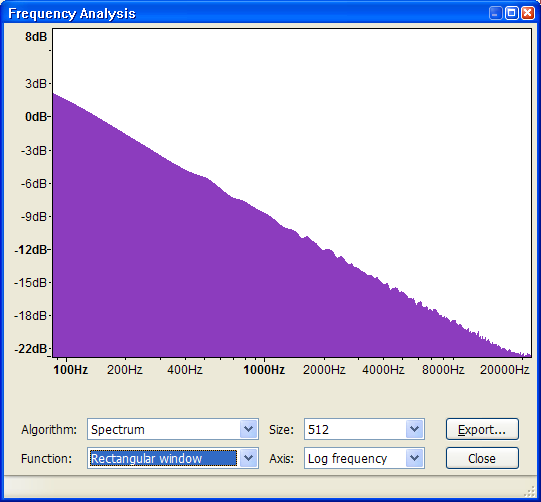does anybody know a good program for measuring the frequency response of mobile phone speaker? I need for a one time test only.
+ Reply to Thread
Results 1 to 18 of 18
-
-
Is there some better, more professional program for measuring the frequency response of mobile phone speaker? In particular, I need test the low frequency range.
-
You do not measure frequency response with a program.
You use an instrument or instruments of some sort,
An obvious simple approach would be to feed ths speaker using a variable frequency signal generator (? computer generated ?) and to measure the output level of the sound from the loudspeaker. Two gadgets and a pencil and paper at least.
As you dont say where you are I can not make further suggestions but a first-world high school is likley to have the necessary equipment.
Perhaps the speaker carries a manufacturers identifier whick you can look up. -
I'm assuming that you want to measure the frequency response with the speaker in its native environment (mounted in the mobile phone chassis). Mounted in the chassis, the frequency response will be different that just the bare speaker mounted in air.
To do this, you need a specialized, sound proof chamber, a specialized and calibrated microphone and a signal generator. Most likely not readily available to the layman, but you could spend a couple thousand dollars and build one yourself.ICBM target coordinates:
26° 14' 10.16"N -- 80° 16' 0.91"W -
As others have indicated, you can just attach any old microphone to your computer, record the sound from your phone, and look at a frequency response graph. Microphones do not have flat frequency responses so you won't be able to tell if any problems are from the mic or from the speaker. You need a calibrated measurement system where the non-linearity of the microphone is compensated for.
-
3Hz fully enough, sure.
I just made some measurement with Audacity 1.2.6
I used standard cheap multimedia Omni-directional condenser microphone with parameters specified:
Frequency response: 20-16000 Hz
Microphone sensitivity: -58 +/- 2dB
S/N ratio: 60 dB or more
I placed a mic near ~5-6cm from speaker, then played Pink Noise mp3 through the phone speaker, recorded it, then analyzed in Plot Spectrum. I'm not sure which values should be be set in dropdown selector opposite the Spectrum, and which mode better use: Log frequency or Linear. I just tried few. Below a few results:




need help to interpret the results.. What's low frequency which can play phone? and which I can cut in High Pass Filter without affecting sound quality? -
Plot the spectrum of the the pink noise source file and you'll see that pink noise should not present a flat spectrum. Amplitude decreases as frequency increases. You probably want to use a frequency sweep or white noise. And still, you won't know what defects are from the mic and what defects are from the speaker. Audacity's pink noise generator:

Frequency Sweep in Audacity:
http://www.storm-consultancy.com/blog/tutorials/sine-wave-frequency-sweep-with-audacity/ -
Why? You can just measure the time from peak to peak to determine the frequency at any point in the cap:Originally Posted by siluet
http://en.wikipedia.org/wiki/Frequency#Definitions_and_units -
You also need to take into account that the measured frequency response includes the fidelity of the mp3-encoded pink noise (mp3 encoding will almost certainly distort it), the phone's D/A converter, the phone's speaker, the microphone and the computer's audio interface.
I used Room EQ Wizard recently to help treat a home studio and it has a bunch of useful tools including correcting for the computer's audio. And it is free.
On the pink noise bit, you could use any of the suggested programs to look at the frequency spectrum. Just analyze the mp3 file directly and then via the phone. The difference between the spectra will give you a good hint at the response of the speaker (with the caveat of what I state above). -
more ideas? I just need professional program. The above programs doesn't suit me.
-
-
Did you compensate for the frequency response of your microphone? If not the plot is pretty meaningless.
Why would you need a high pass filter with a cutoff at 160 Hz? The sample contains virtually nothing down there. -
this graph is from manufacturer's specs of speaker, not mine. I just want supress lower frequences, as mobile speakers can't reproduce very low frequencies, and may even be damaged.
Last edited by siluet; 29th Jan 2010 at 09:44.
Similar Threads
-
Edited sound jumps from speaker to speaker
By len hend in forum AudioReplies: 3Last Post: 23rd Jul 2010, 05:49 -
DVD audio response question
By will7370 in forum Newbie / General discussionsReplies: 0Last Post: 13th Jul 2010, 11:07 -
Measure distance from target in different video formats.
By Adventuredad in forum Newbie / General discussionsReplies: 5Last Post: 19th Apr 2010, 09:52 -
frequency response graph
By siluet in forum AudioReplies: 13Last Post: 10th Feb 2010, 13:11 -
Frequency response correction
By siluet in forum AudioReplies: 6Last Post: 29th Jan 2010, 14:44




 Quote
Quote